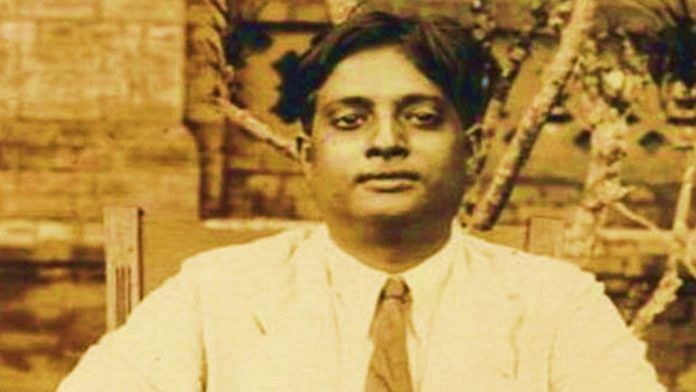On his 125th birth anniversary, ThePrint celebrates one of India’s greatest physicists.
New Delhi: Bose-Einstein statistics, Bose-Einstein Condensate, Bosons — these are terms that even casual observers of physics have heard regardless of whether they actually know about them or not. These nomenclatures, based upon Satyendra Nath Bose’s surname (along with Einstein’s in the first two cases), both commemorate and signify his immense contribution to physics.
Bose’s novel derivation of Planck’s formula without relying upon classical electrodynamics resolved a conceptual inconsistency which had troubled all famous scientists of the day.
The significance of his paper can be gauged by how Abraham Pais in his biography of Einstein, Subtle is the Lord, describes it: “The paper by Bose is the fourth and last of the revolutionary papers of the old quantum theory (the other three being by, respectively, Planck, Einstein, and Bohr).”
On the first day of the new year, ThePrint celebrates the 125th birth anniversary of one of India’s greatest physicists.
Also read: Kolkata scientists develop ground-breaking model to predict solar cycles
Early life and start of academic career
Bose was born on 1 January, 1894, in Calcutta. His father Surendranath Bose was an accountant in the Executive Engineering Department of the East Indian Railways.
Bose completed his high school from the Hindu School, and thereafter, joined Presidency College for further studies. He completed his BSc from the science department in 1913, and his MSc in Mixed Mathematics in 1915. Standing first in both, he enjoyed the privilege of having minds like Meghnad Saha, N.R. Dhar and P.C. Mahalanobis as either his classmates or seniors, men who would later become great physicists, chemists and mathematicians themselves.
After completing his masters, Bose along with Saha started to teach at the newly formed University College of Science in Calcutta. Those were difficult times for any Indian researcher as not only advanced books were unavailable in the library, it was also difficult to order them from abroad because of the ongoing World War I.
Moreover, a lot of the advanced research in physics existed only in French and German, and so Bose and Saha had to teach themselves the two languages. It proved helpful, though, as Saha translated Einstein’s 1905 paper on special relativity into English and Bose his 1916 paper on the foundation of general relativity theory, making them the first translations of Einstein’s famous work in English.
In 1921, Bose moved to Dhaka University from where he would make his most significant contribution to physics.
Letter to Einstein and European sojourn
In 1900, German physicist Max Planck came up with his famous formula describing distribution of energy from a black body radiation. It was one of the seminal events in the development of quantum theory. However, there was a fundamental problem that had to be resolved.
Before Bose, all derivations of Planck’s formula had relied upon classical electrodynamics even though the basic principles of quantum theory are irreconcilable with laws of classical electrodynamics. Bose, however, managed to overcome this problem and came up with a novel derivation. Thereafter, in June 1924, he sent a letter to Albert Einstein in which he attached his research and sought Einstein’s opinion. He also requested him to get the paper published if he likes it.
Einstein not only translated the paper into German and got it published, but also added a translator’s note at the end: “Bose’s derivation of Planck’s formula appears to me an important step forward. The method used here gives also the quantum theory of an ideal gas, as I shall show elsewhere.”
He also sent a letter to Bose in which he acknowledged his work as an “important contribution”.
Bose used the letter to get a two-year research leave in Europe where he made acquaintances with other famous scientists of the period like Paul Langevin and Madame Curie. He joined the laboratory of Maurice de Broglie where he learnt techniques of X-ray spectroscopy and crystallography. He continued his occasional correspondence with Einstein and also managed to meet him in Berlin.
Also read: IIT-Mandi scientists take a leaf from plants to make materials that capture water from fog
Later years
In late 1926, Bose returned to India and was appointed professor of physics and Head of Department at Dhaka University in 1927. He continued to make other important scholarly contributions to physics and wrote papers on a range of subjects like ‘D2 Statistics’, ‘Total Reflection of Electromagnetic Waves in the Ionosphere’, ‘On Lorentz Group’ (concerning relativity), ‘On an Integral Equation of the Hydrogen Atom Problem’, etc.
In 1945, he moved back to Calcutta University from where he retired in 1956. Thereafter, he became Vice-Chancellor of Visva Bharati University, an office he left in 1959.
Bose was a proponent of providing education in the local language (which in his case was Bengali). This belief strengthened after his visits to Japan where he noticed that even complex scientific ideas were discussed in Japanese. He also presided over a meeting that passed a resolution to create a society “Bangiya Bijnan Parishad” with the objective of promoting and popularising science through the regional language.
Bose died on 4 February 1974 at the age of 80.



